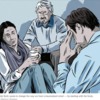Illustration credit: Matthew Woodson, New York Times
Bessel van der Kolk sat cross-legged on an oversize pillow in the center of a smallish room overlooking the Pacific Ocean in Big Sur. He wore khaki pants, a blue fleece zip-up and square wire-rimmed glasses. His feet were bare. It was the third day of his workshop, “Trauma Memory and Recovery of the Self,” and 30 or so workshop participants — all of them trauma victims or trauma therapists — lined the room’s perimeter. They, too, sat barefoot on cushy pillows, eyeing van der Kolk, notebooks in hand. For two days, they had listened to his lectures on the social history, neurobiology and clinical realities of post-traumatic stress disorder and its lesser-known sibling, complex trauma. Now, finally, he was about to demonstrate an actual therapeutic technique, and his gaze was fixed on the subject of his experiment: a 36-year-old Iraq war veteran named Eugene, who sat directly across from van der Kolk, looking mournful and expectant.
Van der Kolk began as he often does, with a personal anecdote. “My mother was very unnurturing and unloving,” he said. “But I have a full memory and a complete sense of what it is like to be loved and nurtured by her.” That’s because, he explained, he had done the very exercise that we were about to try on Eugene. Here’s how it would work: Eugene would recreate the trauma that haunted him most by calling on people in the room to play certain roles. He would confront those people — with his anger, sorrow, remorse and confusion — and they would respond in character, apologizing, forgiving or validating his feelings as needed. By projecting his “inner world” into three-dimensional space, Eugene would be able to rewrite his troubled history more thoroughly than other forms of role-play therapy might allow. If the experiment succeeded, the bad memories would be supplemented with an alternative narrative — one that provided feelings of acceptance or forgiveness or love.
The exercise, which van der Kolk calls a “structure” but which is also known as psychomotor therapy, was developed by Albert Pesso, a dancer who studied with Martha Graham. He taught it to van der Kolk about two decades ago. Though it has never been tested in a controlled study, van der Kolk says he has had some success with it in workshops like this one. He likes to try it whenever he has a small group and a willing volunteer.
Psychomotor therapy is neither widely practiced nor supported by clinical studies. In fact, most licensed psychiatrists probably wouldn’t give it a second glance. It’s hokey-sounding. It was developed by a dancer. But van der Kolk believes strongly that dancers — and musicians and actors — may have something to teach psychiatrists about healing from trauma and that even the hokey-sounding is worthy of our attention. He has spent four decades studying and trying to treat the effects of the worst atrocities we inflict on one another: war, rape, incest, torture and physical and mental abuse. He has written more than 100 peer-reviewed papers on psychological trauma. Trained as a psychiatrist, he treats more than a dozen patients a week in private practice — some have been going to him for many years now — and he oversees a nonprofit clinic in Boston, the Trauma Center, that treats hundreds more. If there’s one thing he’s certain about, it’s that standard treatments are not working. Patients are still suffering, and so are their families. We need to do better.




Comments (0)